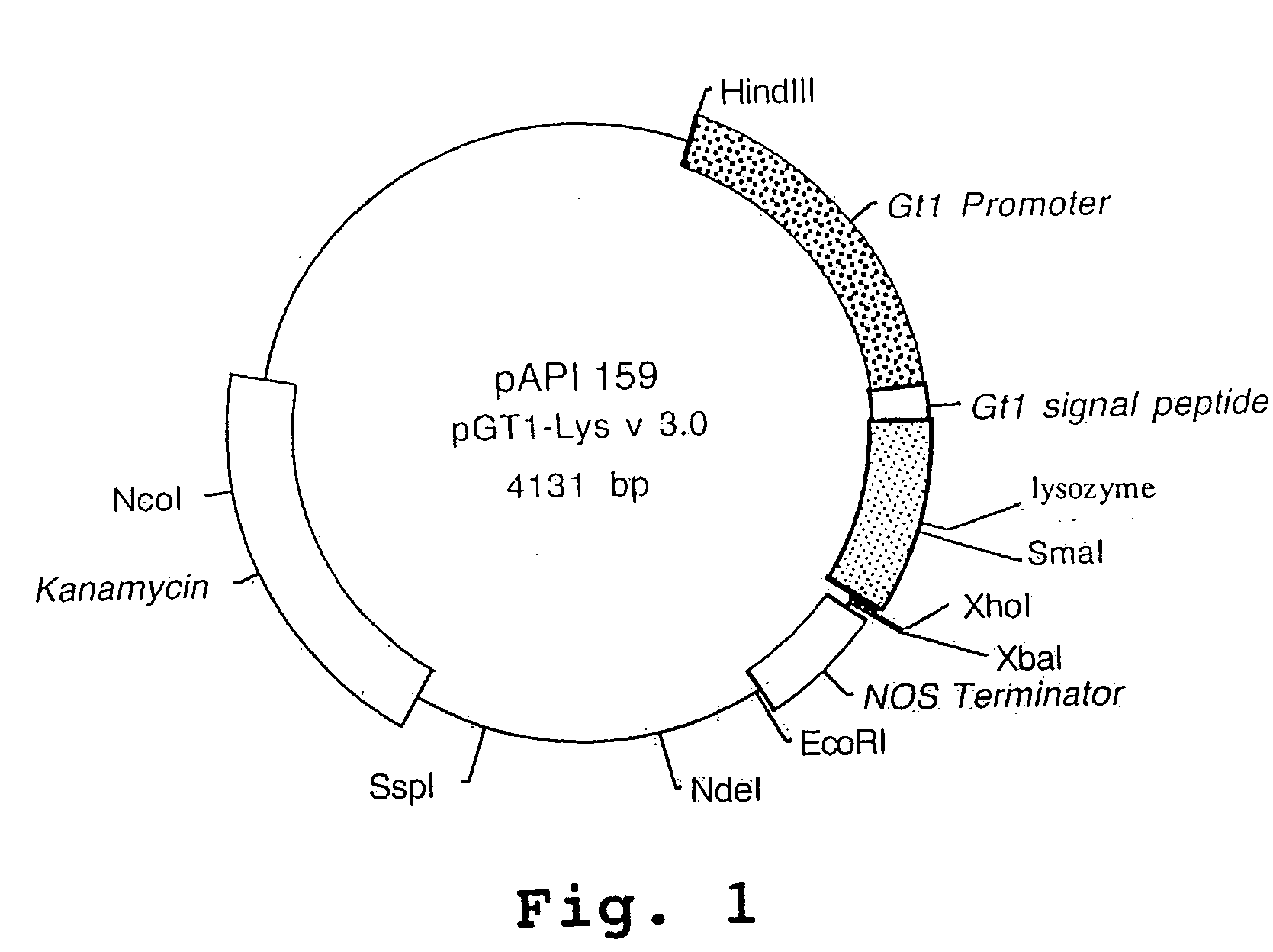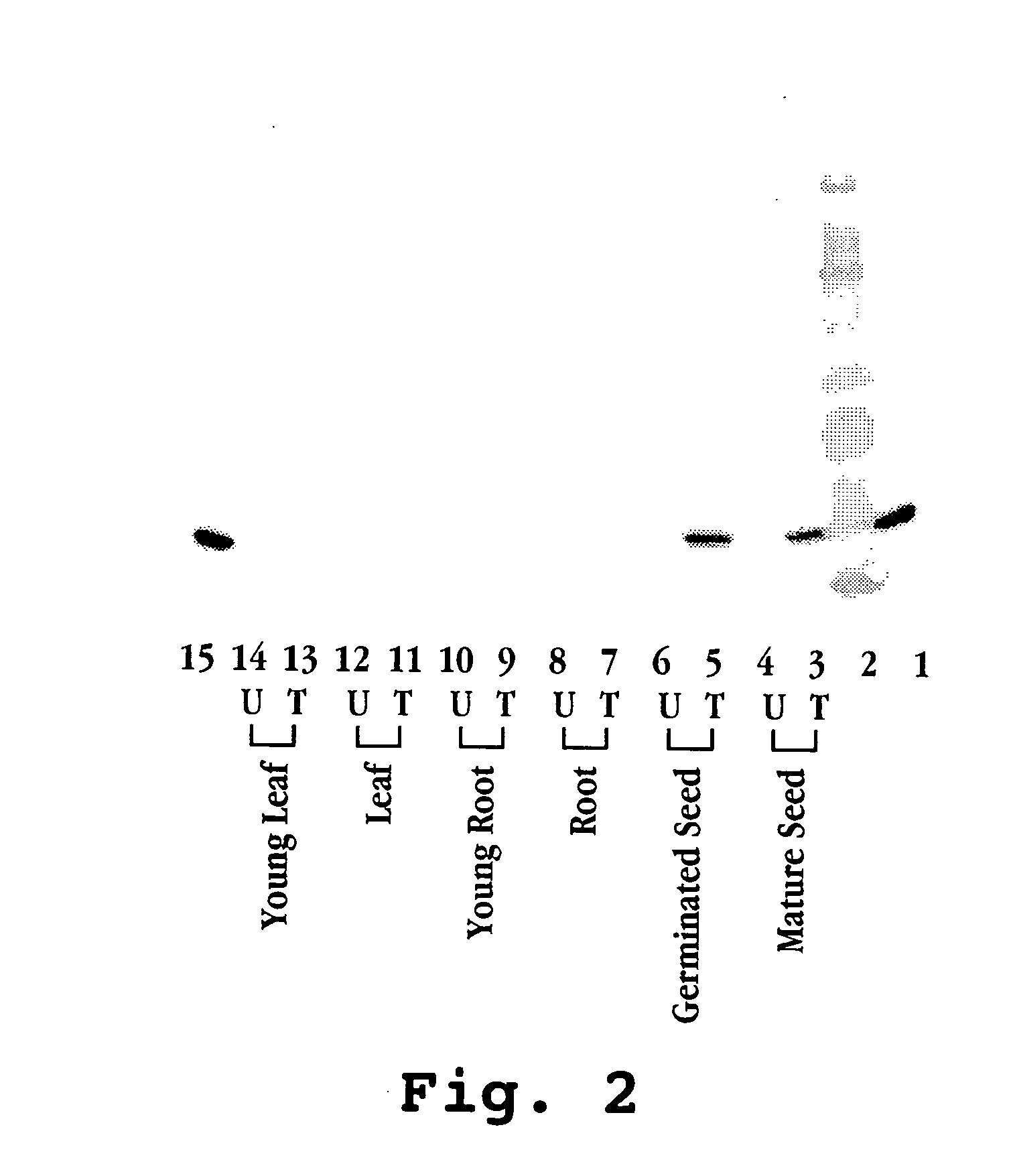Expression of human milk proteins in transgenic plants
a technology of human milk protein and transgenic plants, which is applied in the direction of vector-based foreign material introduction, depsipeptide, plant/algae/fungi/lichens ingredients, etc., can solve the problems of inability to feed infants mother's milk, difficult to digest protein for babies, and different problems,
- Summary
- Abstract
- Description
- Claims
- Application Information
AI Technical Summary
Problems solved by technology
Method used
Image
Examples
example 1
Expression Vectors for Generation of Transgenic Plants
[0353]In general, expression vectors were constructed using standard molecular biological techniques as described in Ausubel et al., 1987. The vectors contain a heterologous protein coding sequence for lactoferrin or lysozyme under the control of a rice tissue-specific promoter, as further described below.
[0354]A. An Expression Vector for Human Lysozyme Expression in Transgenic Rice Cells
[0355]The synthesized lysozyme gene was cloned into an API base vector pAPI137 by conventional molecular cloning techniques (Sambrook et al., 1989). Plasmid pAPI137 contains the RAmy3D promoter (Huang et al., 1993), the codons for the RAmy3D signal peptide and the RAmy3D terminator. The RAmy3D promoter, isolated from the rice amylase gene family, is activated in rice calli by sugar starvation (Huang et al., 1993). The human lysozyme gene was placed between the sequences of the RAmy3D signal peptide and the RAmy3D terminator to give plasmid pAPI15...
example 2
Comparison of Promoter Activity in the Expression of Lysozyme in Transgenic Rice
[0361]A. Comparison Between Gt1 and Glb Promoters and Signal Peptides
[0362]In earlier studies, inconsistencies were observed between promoter activity of Glb and Gt1 from transient assay data and the protein accumulation level in transgenic plants bearing the same promoters with signal peptides. These unpublished studies suggested that post-translational regulation was involved in recombinant protein expression and accumulation in the endosperm. It was unknown whether the storage protein signal peptide played a role in recombinant protein expression level or whether heterologous proteins could be sent to the protein bodies along the sorting pathways of native storage proteins. In order to improve the expression level of recombinant proteins in cereal crop seed, it is important to understand recombinant protein targeting and trafficking in the endosperm expression system. Hence, comparison was made betwee...
example 3
Generation of Transgenic Plants Expressing Human Milk Proteins
[0381]The procedure of microprojectile-mediated rice transformation (U.S. Pat. No. 6,284,956) was followed. Calli was raised from TP309 mature rice seeds, with calli two to four mm in diameter selected and placed on N6 media supplemented with 0.3 M mannitol and 0.3 M sorbitol for 20 hours before bombardment. Biolistic bombardment was carried out with the biolistic PDC-1000 / He system (Bio-Rad, USA). Plasmid carrying milk protein genes and pAPI76, a plasmid carrying hygromycin selectable marker gene were gold-coated and co-bombarded at a ratio of 6:1 with a helium pressure of 1100 psi. Two day old bombarded calli were then transferred to N6 selection media supplemented with 20 mg / l hygromycin B and allowed to grow in the dark at 26° C. for 45 days.
[0382]In order to develop transgenic rice plants, the selected calli were transferred to pre-regeneration and regeneration media. When regenerated plants became 1-3 cm in height, ...
PUM
| Property | Measurement | Unit |
|---|---|---|
| concentration | aaaaa | aaaaa |
| concentration | aaaaa | aaaaa |
| pH | aaaaa | aaaaa |
Abstract
Description
Claims
Application Information
 Login to View More
Login to View More - R&D
- Intellectual Property
- Life Sciences
- Materials
- Tech Scout
- Unparalleled Data Quality
- Higher Quality Content
- 60% Fewer Hallucinations
Browse by: Latest US Patents, China's latest patents, Technical Efficacy Thesaurus, Application Domain, Technology Topic, Popular Technical Reports.
© 2025 PatSnap. All rights reserved.Legal|Privacy policy|Modern Slavery Act Transparency Statement|Sitemap|About US| Contact US: help@patsnap.com



